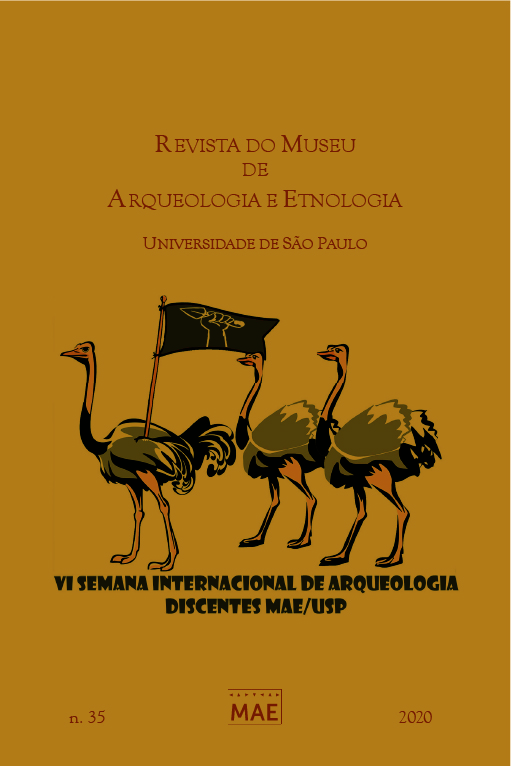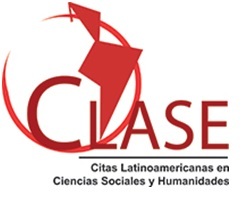Boundaries, doors and walls in the citadel of Mycenae
DOI:
https://doi.org/10.11606/issn.2448-1750.revmae.2020.167055Keywords:
Boundaries, Cyclopean walls, Lion's gate, Monumentality, MycenaeAbstract
This article explores the concept of boundaries in the ancient world using the material and symbolic boundaries produced by the walls and doors of the citadel of Mycenae during the 14th and 14th centuries BC as a case study. This study aims to identify how mycenaean elites materialized their discourse of power in space, be it in the construction of monumental cyclopean walls, in the creation of symbolic landmarks such as the “lion's gate”, or in the purposeful and strategic arrangement of buildings that lie between the main gate and the palace of the mycenaean king. In order to understand the discourse of power employed by the Mycenaean elites, we will analyze the path through which an individual would need to walk from the access gate to the palace at the top of the citadel and which buildings would be protected and privileged on that path. In addition, we will carry out a brief comparative study between the semiology contained in the “lions' gate” and iconographic materials found in funerary context. From the spatial and iconographic analysis we can conclude that the cyclopean walls and the “lion's gate” in Mycenae acts as monumentalized power frontiers, capable of producing behaviors among residents and visitors, regulating flows and legitimizing the power of the elite, through symbols and buildings connected to religion and ancestors,.
Downloads
References
Aldrovandi, C.; Hirata, E. F. V.; Kormikiari, M. C. (orgs.) 2011. Estudos sobre o Espaço na Antiguidade. Editora da Universidade de São Paulo, São Paulo.
Blackwell, N. 2014. Making the Lion Gate Relief at Mycenae: Tool Marks and Foreign Influence. American Journal of Archaeology, vol. 118, n°. 3: 451–488. Disponível em: <https://www.jstor.org/stable/10.3764/aja.118.3.0451?seq=1>. Acesso em 27 fev. 2020.
Castledan, R. 2005. Mycenaeans. Routledge, Nova Iorque, 2005.
Cline, E. 2010. The Bronze Age Aegean (ca. 3000-1000 BC). Oxford University Press.
Conant, C.; Thomas, C. 1999. Citadel to City-State. Indiana University Press, Bloomington.
Evans, A. 1901. Mycenaean Tree and Pillar Cult and Its Mediterranean Relations. The Journal of Hellenic Studies, vol. 21: 99-204.
Fletcher, F. 1941.Tiryns, Argos, Mycenae in Legend and Literature. Greece & Rome, vol. 11, n°. 31: 1-9. Disponível em: <https://www.jstor.org/stable/641398?seq=1>. Acesso em: 27 fev. 2020.
Gras, M. 1995. O Mediterrâneo Arcaico. Editorial Teorema, Lisboa.
Guarinello, N. 2010. Ordem, Integração e Fronteiras no Império Romano: Um Ensaio. Mare Nostrum (São Paulo), v. 1, n. 1: 113-127. Disponível em: <http://www.revistas.usp.br/marenostrum/article/view/105764/104473>. Acesso em: 27 fev. 2020.
Hirata, E. F. V.; Florenzano, M. B. B. 2009. Estudos sobre a cidade antiga. Editora da Universidade de São Paulo/Fapesp, São Paulo.
Hope Simpson, R.; Hagel, D. 2006. Mycenaean fortifications, highways, dams and canals. Studies in Mediterranean Archaeology, vol. CXXXIII. : Paul Aströms Förlag, Sävedalen.
Iakovidis, S.1983. Late Helladic Citadels on Mainland Greece. Brill, Leiden.
Jansen, A. 1994, Stations along the roads in the area of Mycenea. University of Pensilvania.
Kenna, V. E. G. 1967. Die englischen Museen II. British Museum, London.
Lamont, M; Molnár, V. 2002. The Study of Boundaries Across the Social Sciences. Annual Review of Sociology, n° 28: 167-195. Disponível em: <https://scholar.harvard.edu/files/lamont/files/m.lamont-v.molnar-the_study_of_boundaries.pdf>. Acesso em: 27 fev. 2020.
Loader, N. 1996. A Possible East Sally-Port in the North-East Extension at Mycenae? A Brief Note. The Annual of the British School at Athens, vol. 91: 191–196. Disponível em: <https://www.jstor.org/stable/30102547?seq=1>. Acesso em: 27 fev. 2020.
Machado, L. 1998. Limites, fronteiras e redes. In: Srohaecker, T., et al. (orgs.). Fronteiras e Espaço Global. AGB, Porto Alegre.
Machado, L. 2006. Cidades na Fronteira Internacional: conceitos e tipologia. In: II Conferência internacional de desenvolvimento urbano em cidades de fronteira. Instituto de Arquitetos do Brasil, Foz do Iguaçu: 58-69.
Pausânias. 1918. Description of Greece, Translated by W.H.S. Jones and H.A. Ormerod. William Heinemann Ltd., London.
Rapoport, A. 1969. House form and Culture. Prentice-hall Inc.
Robertson, A. 1997. Arquitetura grega e romana. Martins Fontes, São Paulo.
Thomas, N. 2004. The Early Mycenaean Lion up to Date. Hesperia Supplements, vol. 33: 161–206. Disponível em: <https://www.jstor.org/stable/pdf/1354068.pdf?seq=1>. Acesso em: 27 fev. 2020.
Trigger, B. 1990. Monumental Architecture: A Thermodynamic Explanation of Symbolic Behaviour. World Archaeology, vol. 22, n°2: 119-132. Disponível em: <https://www.jstor.org/stable/124871?seq=1>. Acesso em: 27 fev. 2020.
Downloads
Published
Issue
Section
License
Copyright (c) 2020 Gustavo Jorge Peloso Peixoto

This work is licensed under a Creative Commons Attribution-NonCommercial-NoDerivatives 4.0 International License.













